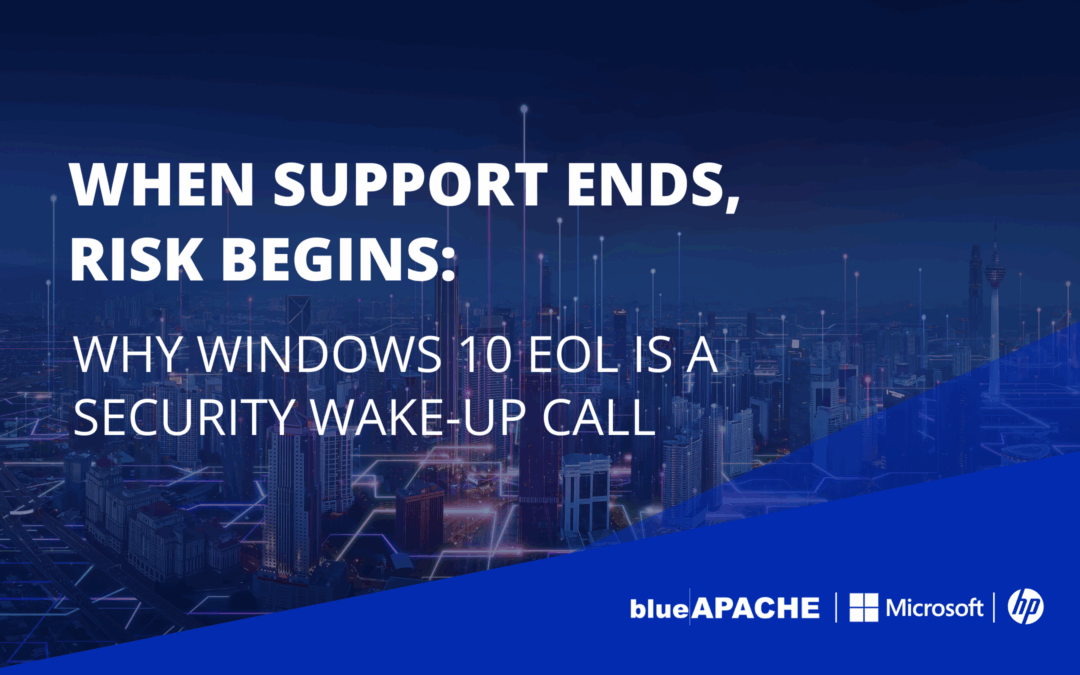Request Your Tailored Upgrade or Refresh Plan with blueAPACHE and go into the draw to win a HP Elitebook.
When Windows 10 reaches End of Life on October 14, 2025, it will quietly expose millions of devices to unnecessary risk. After this date, Microsoft will no longer provide security updates or technical support, leaving systems vulnerable to new threats, compliance gaps, and operational breakdowns.
This isn’t just an IT milestone. It’s a security deadline with real business consequences.
In the current climate, where boards are demanding tighter controls, insurers are scrutinising coverage terms, and attackers are growing more sophisticated, unsupported devices are more than just outdated, they’re a liability. Organisations that delay upgrades may not feel the impact immediately, but the cost of inaction will surface in ways that are harder to predict, and even harder to reverse.
Security leaders know this. But knowing isn’t the problem, acting is.
The Real Risk Of Inaction
After the EOL deadline, any device still running Windows 10 will be left without essential protections. That means any vulnerability discovered after October 14 won’t be patched. In a hybrid environment, where devices are distributed and network perimeters are fluid, one exposed endpoint can become the weakest link in an otherwise well-managed environment.
Even for businesses that believe their risk is low, the operational costs of managing outdated infrastructure can quietly mount. IT teams spend more time troubleshooting. Users experience slower performance. Temporary workarounds become permanent fixes. And over time, these inefficiencies affect productivity, morale, and budget, particularly when something breaks under pressure.
The mistake many organisations make is viewing EOL as a technical task rather than a strategic opportunity. But in reality, this is a chance to get ahead of risk, optimise costs, and lay the groundwork for a more resilient IT environment.
The Hidden Strain Of Legacy Devices
Legacy devices might seem like a safe option: already paid for, still functional. But they often create more strain than value. From slower boot times to compatibility issues with modern apps and platforms, aging hardware can quietly erode performance across the business. IT teams spend more time troubleshooting. Staff lose time to delays. Minor disruptions become regular friction points.
Over time, these small inefficiencies snowball into real business impact: lost productivity, frustrated users, and greater exposure to security vulnerabilities. Refreshing your device fleet isn’t just about staying current, it’s about removing the friction that slows people down and drains IT resources.
Why Cybersecurity, Cost Control, And ESG Go Hand In Hand
What makes this moment especially important is the convergence of risk, regulation, and responsibility. It’s no longer just about protecting endpoints or upgrading for performance. It’s about aligning IT decisions with broader business values, including environmental, social, and governance (ESG) outcomes.
Sustainability may not seem like a security issue at first glance, but when devices are lost in the system, improperly decommissioned, or disposed of without oversight, they introduce both environmental and data risk. Similarly, fixed refresh cycles that retire usable equipment too early contribute to unnecessary waste and overspend.
More IT leaders are beginning to view device strategy through a longer lens. That includes looking at energy efficiency ratings, lifecycle extension options, and structured programs for trade-in, buy-back, or donation. Done right, these practices don’t just reduce landfill, they help control costs, improve accountability, and support an organisation’s ESG posture.
Making The Most Of The Lead Time
The strongest transitions start before the deadline is looming. By acting early, you can avoid last-minute compromises and spread upgrade investments over time.
That might mean starting with the riskiest or most critical endpoints, or using the refresh as a chance to shift toward a more modern device lifecycle strategy. Whatever your approach, the key is to ensure the plan isn’t just reactive, it’s purposeful.
At blueAPACHE, we work with technology and finance leaders to bring structure, clarity, and confidence to the Windows 10 transition. Whether you’re ready to act now or still mapping out next steps, we can help you assess your risk, explore upgrade options, and build a plan that balances security, usability, and long-term value.
Request your tailored upgrade or refresh plan today and go into the draw to win a premium HP EliteBook.

